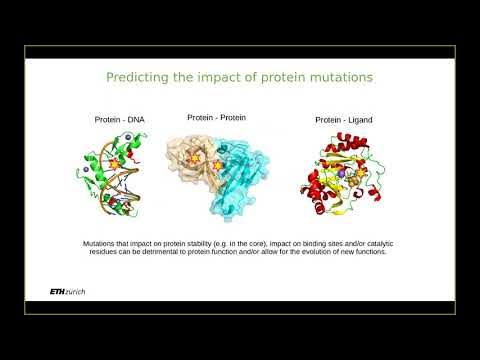How AI Cracked the Protein Folding Code and Won a Nobel Prize
Summary
TLDRThis video explores the groundbreaking advancements in protein folding research, particularly through DeepMind's AlphaFold, which uses artificial intelligence to predict protein structures with remarkable accuracy. Overcoming decades of challenges in structural biology, AlphaFold's success has opened new avenues for drug discovery and protein design, as seen in the works of David Baker, John Jumper, and Demis Hassabis. The video highlights the evolving landscape of computational biology, emphasizing the importance of understanding protein interactions within cells and the implications for future scientific innovations.
Takeaways
- 😀 Proteins are crucial molecular machines essential to life, performing a wide range of vital functions.
- 😀 The 'protein folding problem' involves understanding how amino acid sequences determine a protein's 3D shape and function.
- 😀 DeepMind's AlphaFold revolutionized protein structure prediction, achieving unprecedented accuracy in the CASP 14 competition.
- 😀 Historical methods for determining protein structures, like X-ray crystallography, are time-consuming and expensive.
- 😀 Advances in AI, particularly deep learning, have enabled rapid and precise protein structure predictions, fundamentally changing structural biology.
- 😀 AI tools like RoseTTAFold and AlphaFold 3 have expanded capabilities to predict protein interactions and complex structures.
- 😀 The collaboration between computational and experimental biology has led to new methodologies for protein design and engineering.
- 😀 The 2024 Nobel Prize in Chemistry was awarded to David Baker, John Jumper, and Demis Hassabis for their groundbreaking work in protein structure prediction.
- 😀 The field of computational biology is evolving rapidly, with ongoing challenges and opportunities for further discovery.
- 😀 AI's role in biology is expected to grow, enabling researchers to tackle problems that were previously unsolvable.
Q & A
What is the significance of proteins in biological systems?
-Proteins are essential molecular machines that perform vital functions, including catalyzing biochemical reactions and providing structure to tissues.
What is the 'protein folding problem'?
-The protein folding problem refers to the challenge of understanding how a sequence of amino acids encodes a protein's three-dimensional shape and how to predict that structure computationally.
What role did John Kendrew play in structural biology?
-John Kendrew revealed the first atomic protein structure using X-ray crystallography in 1957, which became a crucial technique for structural biologists.
How did DeepMind contribute to solving the protein folding problem?
-DeepMind developed AlphaFold, an AI algorithm that significantly improved the accuracy of protein structure predictions, culminating in AlphaFold 2's success in the CASP 14 challenge.
What advancements did AlphaFold 2 bring to protein structure prediction?
-AlphaFold 2 utilized deep learning to achieve highly accurate predictions, with many results scoring 90 or above in the CASP 14 evaluation.
What are the main components of AlphaFold 2's algorithm?
-AlphaFold 2 combines multiple sequence alignments and pairwise representations of amino acids, utilizing transformer networks for refined predictions.
What is the significance of CASP in the field of protein prediction?
-CASP, or the Critical Assessment of Structure Prediction, organizes community efforts to evaluate and improve computational predictions of protein structures.
What new capabilities did the Baker Lab introduce with RoseTTAFold All-Atom?
-RoseTTAFold All-Atom predicts the 3D structures of protein assemblies and small molecules, allowing for more complex structural predictions.
What does AlphaFold 3 add to the protein prediction landscape?
-AlphaFold 3 introduces diffusion-based methods for predicting both binding structures and interactions of proteins with other molecules, enhancing its capabilities.
What recognition did David Baker, John Jumper, and Demis Hassabis receive for their contributions?
-In October 2024, they were awarded the Nobel Prize in Chemistry for their groundbreaking work in protein structure prediction and design.
Outlines

Cette section est réservée aux utilisateurs payants. Améliorez votre compte pour accéder à cette section.
Améliorer maintenantMindmap

Cette section est réservée aux utilisateurs payants. Améliorez votre compte pour accéder à cette section.
Améliorer maintenantKeywords

Cette section est réservée aux utilisateurs payants. Améliorez votre compte pour accéder à cette section.
Améliorer maintenantHighlights

Cette section est réservée aux utilisateurs payants. Améliorez votre compte pour accéder à cette section.
Améliorer maintenantTranscripts

Cette section est réservée aux utilisateurs payants. Améliorez votre compte pour accéder à cette section.
Améliorer maintenantVoir Plus de Vidéos Connexes

생물학 50년 난제 해결한 인공지능 '알파폴드', 생물학,의학 패러다임의 대전환?! [안될과학-초긴급과학]

PTP - Structural Bioinformatics 3

What if all the world's biggest problems have the same solution?

Can AI Catch What Doctors Miss? | Eric Topol | TED

What's next for AI at DeepMind, Google's artificial intelligence lab | 60 Minutes

Artificial intelligence helps trio of protein pioneers win Nobel Prize in Chemistry | DW News
5.0 / 5 (0 votes)
